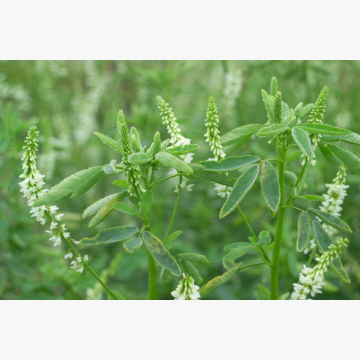- Home
- Seeds
- Oil / seasoning plants, etc.
- White sweet clover
- White sweet clover KUUSIKU
FOR CONSULTATIONS APPLY TO:
Commercial director
Lina Smalskienė
tel. +370 618 02 551
e-mail linak@agrolitpa.lt
Sales manager
Tautvydas Kliučininkas
tel. +370 681 35 093
e-mail tautvydask@agrolitpa.lt
Sales manager
Eglė Petkevičienė
tel. +370 626 95 458
e-mail eglep@agrolitpa.lt
Sales manager
Kotryna Nakrošytė
tel.: +370 601 39 282
e-mail kotryna@agrolitpa.lt
White sweet clover KUUSIKU
High-yielding, disease-resistant, nectareous white sweet clover used as a forage crop, for improvement of non-fertile soils and as a good green-manure plant
- Produces a lot of biomass (4-7.5 t/ha of dry matter)
- Plants – erect
- Stems – thin/medium thin, medium length/long
- Leaves – small, elliptic, pale green/green in colour
- Flowers – white
- Plants – biennial
- Resistant to diseases
- Plants are nectareous
- Can be used for green manure
- A strong root system loosens the soil
- The soil is enriched with nitrogen (100-150 kg N/ha)
- Thanks to the long and strong roots, white sweet clover tolerates drought very well, grows well in both light and heavy soils, as long as they are not acidic (pH 7-8) or calcareous, does not tolerate water-lodging
- Acidic soils should be limed before cultivation
- Sowing time: from early spring to the end of July
- White sweet clover is perfect for growing as sidereal crop, especially in organic farms
- Used in the second year of growth for fodder, green manure or seed
- White sweet clover is an excellent pre-crop for all plants. It can be grown alone and as under-sowing crop. The seed is very small, with a hard shell, it needs a lot of moisture to germinate, so it should be sown as early as possible in the spring. Before sowing, it is recommended to scarify the seeds with a special scarifier, then the seeds will germinate faster. To obtain a good yield of green mass, it is advised to apply nitragin (root nodule, nitrogen-fixing bacteria) to the seed, especially in those fields where white sweet clover was never grown
- The information for beekeepers says that white sweet clover can be sown in buckwheat crop. After buckwheat is sown, on the same day, white sweet clover is also sown. It is best to sow crossing buckwheat rows. After sowing, the crop should be harrowed or rolled with rollers on a smooth surface. Buckwheat overshadows other plants as it grows, but white sweet clover manage to survive and grow
- After wintering, the white sweet clover grows rapidly and begins to bloom in June. It blooms for three to four weeks, in June-July. Bees can produce around 600 kg/ha of honey from the white sweet clover grown for seed in arable land
- White sweet clover grown for green manure should be ploughed at the beginning of flowering. Before ploughing, to prevent clogging of the ploughs, plants of white sweet clover should be chopped or flattened.
The varietal parameters may differ from those indicated here when the testing circumstances differ from quondam
Recommended sowing rate: 20-30 kg/ha. When growing as an under sowing crop, the seed rate should be increased to 30 kg/ha
Recommended sowing rate when growing for green manure: 25-35 kg/ha kg/ha
Keravos sreet. 17, Kerava,
LT-38 131 Panevėžys district, LITHUANIA
Enterprise's code 168598128
VAT code LT685981219
Tel. +370 615 11 315
E. mail info@agrolitpa.lt




.JPG)

